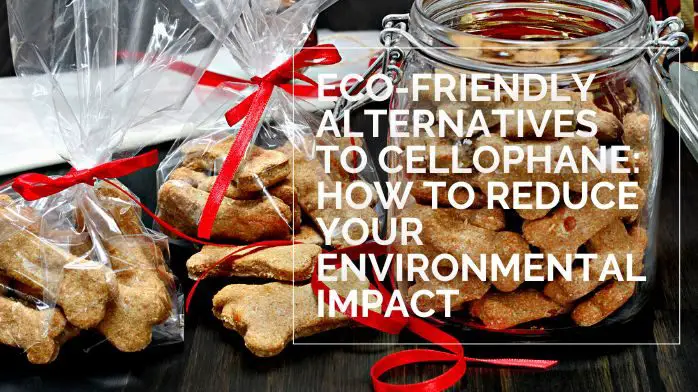Cellophane bags are made of a thin, transparent film called cellophane. They are commonly used for packaging food, candies, and small gift items.
Cellophane bags are also used to protect and store items like clothes, sheets, and other household items. They are made of a moisture-resistant material, which makes them suitable for food packaging, as they can help to keep food fresh and prevent it from getting damaged by moisture. Cellophane bags are also popular for their transparency, which allows the bag’s contents to be easily visible.
Can You Throw Away Cellophane?
Cellophane can be thrown away in the trash. It is not biodegradable, so it will not break down naturally in the environment. However, it is relatively lightweight and takes up little landfill space, so it does not contribute significantly to waste.
If you are looking to reduce your environmental impact, there are some alternatives to using cellophane bags that you might consider. For example, you could use reusable cloth bags, paper bags, or bags made of biodegradable materials like cornstarch or potato starch. These options are more environmentally friendly than cellophane, as they can be reused or broken down naturally in the environment.

Recycling Cellophane
While cellophane is not biodegradable, it can be recycled. The recycling process for cellophane involves breaking down the material into a pulp, which can then be used to make new products. However, the recycling rate for cellophane is low, as it can be challenging to collect and process due to its lightweight and transparent nature.
If you want to recycle cellophane, it is essential to check with your local recycling program to see if they accept it. Some programs may take cellophane, while others may not. If your recycling program does not accept cellophane, you may be able to find a company that specializes in recycling this material.
In general, the best way to reduce the environmental impact of cellophane is to use it sparingly and recycle it when possible. You can also consider using alternative materials like cloth bags, paper bags, or bags made of biodegradable materials, which are more environmentally friendly.
Where to Recycle Cellophane
The availability of cellophane recycling programs can vary depending on your location. Some cities and towns may have curbside recycling programs that accept cellophane, while others may not. It is best to check with your local recycling program to see if they accept cellophane and the guidelines for recycling it.
If your local recycling program does not accept cellophane, you may be able to find a company that specializes in recycling this material. You can do an internet search to find a cellophane recycling company near you. Alternatively, you can check with local businesses or organizations using cellophane packaging to see if they have a recycling program.
It is essential to recycle cellophane whenever possible to reduce its environmental impact. You can also consider using alternative materials like cloth bags, paper bags, or bags made of biodegradable materials, which are more environmentally friendly.
Benefits of Recycling Cellophane
Recycling cellophane has several benefits, both for the environment and society as a whole. Some of the benefits of recycling cellophane include the following:
- Reducing waste: Recycling cellophane helps to reduce the amount of waste that ends up in landfills. This is important because landfills can take up a lot of space and have negative environmental impacts, such as releasing greenhouse gases and contaminating soil and water.
- Conserving natural resources: Recycling cellophane conserves natural resources, such as wood and oil, used to make new products. This is because recycled cellophane can create new products, reducing the need to extract and process raw materials.
- Reducing greenhouse gas emissions: Recycling cellophane can also help to reduce greenhouse gas emissions. The production of new products from raw materials requires energy, often from burning fossil fuels. Recycling cellophane minimizes the need for this energy, leading to fewer greenhouse gas emissions.
- Supporting the economy: Recycling cellophane can also support the economy by creating jobs in the recycling industry and reducing the demand for new products made from raw materials. This can help to stimulate economic growth and create a more sustainable economy.
Recycling cellophane has numerous benefits for the environment and society and is essential in reducing our impact on the planet.
Eco-friendly Cellophane Alternatives
Several options are available if you are looking for eco-friendly alternatives to cellophane. Some options include:
- Cloth bags: Cloth bags are reusable and can be used to package and store various items. They are made from natural materials like cotton, which are biodegradable and can be easily recycled.
- Paper bags: Paper bags are another eco-friendly alternative to cellophane. They are made from trees, which are renewable resources. Paper bags can be recycled and biodegradable, making them more sustainable.
- Biodegradable plastic bags: Some plastic bags are made from biodegradable materials like cornstarch or potato. These bags break down naturally in the environment, making them a more sustainable alternative to traditional plastic bags.
- Glass containers: Glass containers are a durable and eco-friendly alternative to cellophane for food storage and packaging. They are made from natural materials, can be recycled indefinitely, and do not leach chemicals into the food they contain.
There are many eco-friendly alternatives to cellophane available. By choosing reusable or biodegradable options, you can help to reduce your environmental impact and support a more sustainable future.
Conclusion
Cellophane is a thin, transparent film commonly used to package food, candies, and small gift items. It is not biodegradable but can be recycled to reduce its environmental impact.
If you are looking for eco-friendly alternatives to cellophane, several options are available, including cloth bags, paper bags, biodegradable plastic bags, and glass containers. By choosing reusable or biodegradable options, you can help to reduce your environmental impact and support a more sustainable future.

